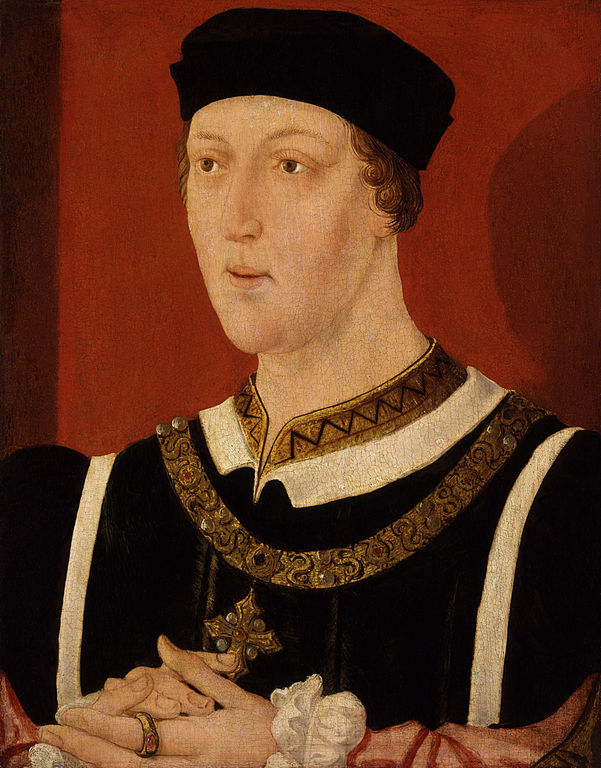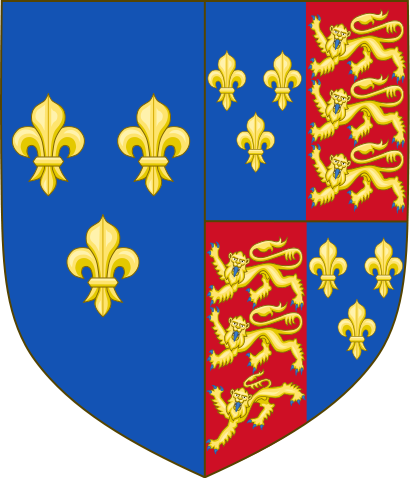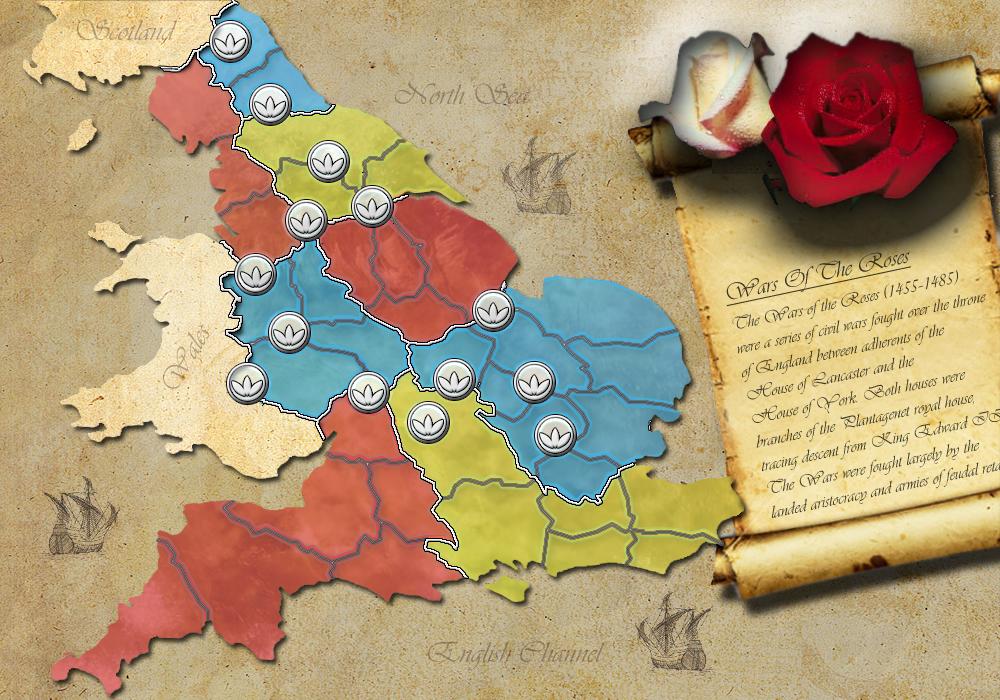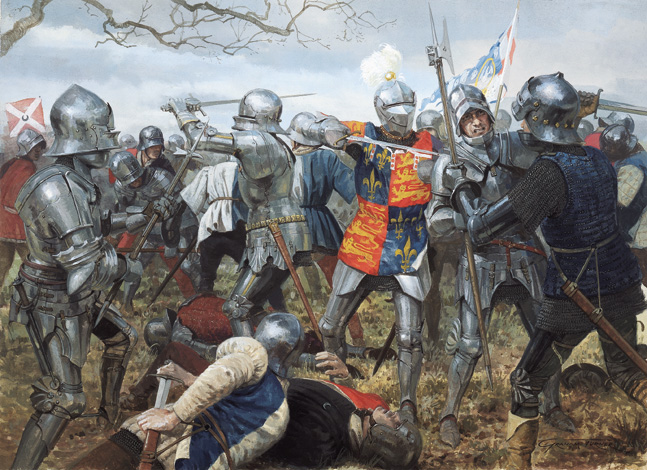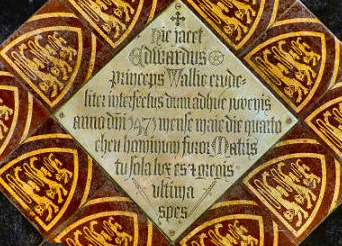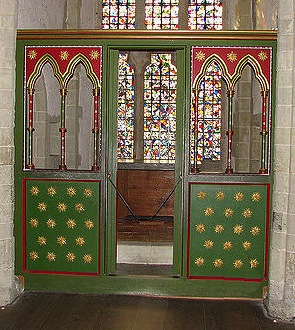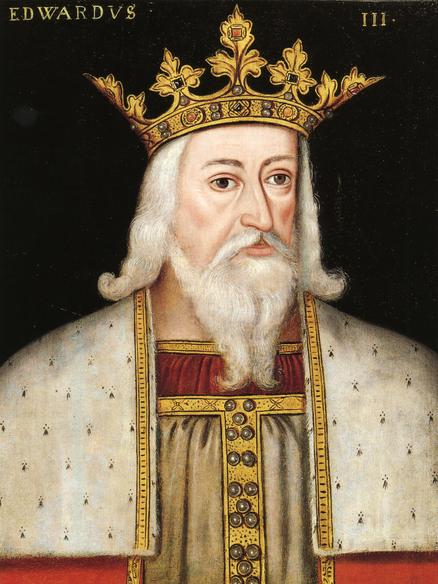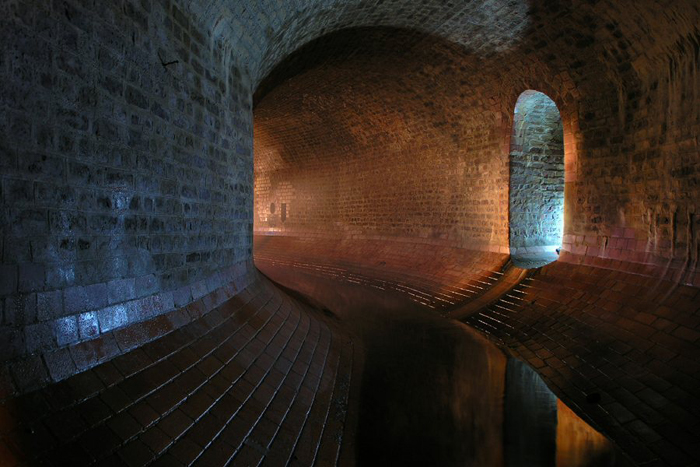Name: King Henry VI
Born: December 6, 1421 at Windsor Castle
Parents: Henry V and Catherine of Valois
Relation to Elizabeth II: 14th great-granduncle
House of: Lancaster
Ascended to the throne: September 1, 1422
Crowned: November 6, 1429 at Westminster Abbey, aged 7. St Pauls Cathedral, aged 48. Also crowned Henri II of France, December 1431, Cathedral of Notre Dame, Paris, aged 10.
Married: Margaret, Daughter of Count of Anjou
Children: One son
Died: May 21, 1471 at Tower of London (murdered), aged 49 years, 5 months, and 13 days
Buried at: Chertsey, reburied in 1485 when his body was moved to St George’s Chapel, Windsor Castle.
Reigned for: 39 years, 1 month, and 18 days, Deposed March 4, 1461, Restored Oct 3, 1470
Succeeded by: his distant cousin Edward IV
King of England from 1422, son of Henry V. He assumed royal power 1442 and sided with the party opposed to the continuation of the Hundred Years’ War with France. After his marriage 1445, he was dominated by his wife, Margaret of Anjou. He was deposed 1461 in the Wars of the Roses; was captured 1465, temporarily restored 1470, but again imprisoned 1471 and then murdered.
Henry was eight months old when he succeeded to the English throne, and shortly afterwards, by the death in 1422 of his maternal grandfather, Charles VI, he became titular king of France. Unlike his father, Henry was disinclined to warfare, and when Joan of Arc revived French patriotism the English gradually began to lose their French possessions. By 1453 only Calais remained of his father’s conquests.
The unpopularity of the government, especially after the loss of the English conquests in France, encouraged Richard, Duke of York, to claim the throne, and though York was killed 1460, his son Edward IV proclaimed himself king 1461.
| Timeline for King Henry VI |
| 1422 | Henry aged 8 months becomes King of England on the death of his father, Henry V, and then, two months later, King of France on the death of his grandfather, Charles VI. |
| 1422 | John, Duke of Bedford, is appointed Regent of France; Humphrey, Duke of Gloucester, becomes Regent of England. |
| 1429 | Henry VI is crowned King of England |
| 1429 | The young peasant girl Joan of Arc begins her campaign to expel the English from France. She inspires the French army which relieves Orleans besieged by English troops. |
| 1431 | The English capture Joan of Arc. She is burned at the stake as a witch and heretic in Rouen on 30 May. |
| 1431 | Henry VI of England is crowned King of France in Paris |
| 1437 | Henry assumes personal rule of England |
| 1440 | Eton college founded giving free education to 70 scholars |
| 1445 | Henry marries Margaret of Anjou |
| 1453 | End of 100 Years’ War. Gascony and Normandy fall to the French. England retains only Calais and The Channel Islands. |
| 1453 | Henry becomes mentally ill. Richard, Duke of York, is made Protector during Henry’s illness |
| 1453 | Battle of Heworth between supporters of the Neville and Percy families marks the beginning of the feud between the Houses of York and Lancaster |
| 1454 | Henry regains his senses but disaffected nobles take matters into their own hands. Supporters of the Dukes of York and Lancaster take sides. |
| 1455 | Beginning of the ‘Wars of the Roses’. Duke of York is dismissed. York raises an army and defeats the King’s Lancastrian forces at the Battle of St. Albans.The Lancastrian leader, the Duke of Somerset, is killed. York takes over the government of England. |
| 1457 | Henry unsuccessfully tries to broker peace between the Yorkists and Lancastrians. |
| 1459 | War is renewed and the Lancastrians are defeated at Blore Heath; the Yorkists are then defeated at Ludford Bridge near Ludlow. Parliament declares York a traitor and he escapes to Ireland. |
| 1460 | Yorkist army led by Richard Neville, Earl of Warwick, defeats Lancastrians at the Battle of Northampton. Henry VI is captured and his wife, Margaret, escapes to Scotland. Richard of York is again Protector. |
| 1460 | Margaret raises a Lancastrian army in the north and defeats and kills Richard of York at Wakefield. Henry VI captured by the Yorkists at Northampton. Earl of Warwick takes London for the Yorkists. |
| 1461 | Yorkists win Battle of Mortimers Cross. Queen Margaret marches her army South, defeats Earl of Warwick at St Albans, and frees Henry. Edward, son of Richard of York, defeats Margaret’s Lancastrian forces on 29 March at the Battle of Towton – the largest and bloodiest battle ever on British soil when 28,000 lose their lives. Margaret and Henry flee to Scotland. Henry is deposed by Edward who declares himself King Edward IV |
| 1462 | Lancastrian revolts are suppressed. |
| 1464 | Warwick defeats Lancastrians at Battle of Hexham; Henry VI is captured and brought to the Tower of London. |
| 1469 | Warwick falls out with Edward IV, and defeats him at Edgecote. They are later reconciled but Warwick is banished. He makes peace with Margaret, returns to England with an army, and Edward flees to Flanders. Henry VI is restored to the throne. |
| 1471 | Edward returns to England and defeats and kills Warwick at the Battle of Barnet. Margaret is defeated at the Battle of Tewkesbury; her son Edward, Prince of Wales, heir to the Lancastrian throne is killed in battle. |
| 1471 | Henry is murdered by being stabbed to death in the Tower of London. |
Henry VI (6 December 1421 – 21 May 1471) was King of England from 1422 to 1461 and again from 1470 to 1471, and disputed King of France from 1422 to 1453. Until 1437, his realm was governed by regents. Contemporaneous accounts described him as peaceful and pious, not suited for the dynastic wars, known as the Wars of the Roses, which were to commence during his reign. His periods of insanity and his inherent benevolence eventually required his wife, Margaret of Anjou, to assume control of his kingdom, which contributed to his own downfall, the collapse of the House of Lancaster, and the rise of the House of York.
Henry VI’s Minority
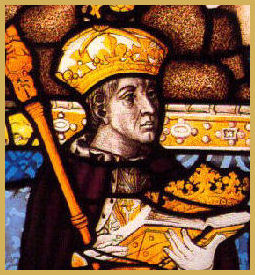 The last king of the Lancastrian dynasty, Henry VI was born at Windsor Castle on 6th December, 1421 the son of Henry V and Catherine of Valois, daughter of Charles VI of France. Henry became King of England in his cradle, he was barely nine months old when his famous father, Henry V, died of dysentry on campaign in France. Two months later he became King of France also, when his grandfather, the mentally unstable Charles VI, died.
The last king of the Lancastrian dynasty, Henry VI was born at Windsor Castle on 6th December, 1421 the son of Henry V and Catherine of Valois, daughter of Charles VI of France. Henry became King of England in his cradle, he was barely nine months old when his famous father, Henry V, died of dysentry on campaign in France. Two months later he became King of France also, when his grandfather, the mentally unstable Charles VI, died.
During Henry’s minority, the war in France had been executed loyally and ably by his paternal uncle, John, Duke of Bedford. He struggled with the almost impossible task of retaining his brother’s conquests in France. England was ruled by a council lead by Humphrey, Duke of Gloucester, the youngest of Henry V’s brothers.
In November 1429, the young king was considered old enough to undergo the arduous coronation ceremony and was crowned at Westminster Abbey at eight years old. The following year, at the age of nine, he crossed to his French kingdom and was crowned King of France at Notre Dame. In the streets of Paris he was observed from an upper storey window by his notorious grandmother, Isabeau of Bavaria, the wanton widow of Charles VI, whom the young king courteously doffed his hat to.
Henry’s mother, Catherine of Valois, died in 1437 amidst scandal, when it was discovered that the Dowager Queen had contacted a secret marriage with her Welsh clerk of the wardrobe, Owen Tudor and had borne him several children, three sons and a daughter. Henry later created the eldest of these half-brothers, Edmund and Jasper Tudor, Earls of Richmond and Pembroke respectively. Both were later to play leading parts in the Wars of the Roses, the elder, Edmund was to become the father of King Henry VII, the founder of England’s Tudor dynasty. Owen Tudor was summoned before the king’s council to explain his conduct, but was released without punishment, he ended his days in 1461, when after fighting on the Lancastrian side at the Battle of Mortimer’s Cross, he was beheaded on the orders of Henry’s supplanter, Edward IV.
The wheel of fortune had begun to turn against the English in France. Joan of Arc lead the French to victory, and by 1453, all of the great Henry V’s conquests, apart from Calais, were lost.
Personal Rule
According to the terms of a peace agreement with France, Henry married Margaret of Anjou, daughter of Rene, Duke of Anjou and titular King of Jerusalem and Isabella, Duchess of Lorraine. Margaret was also the niece of the French King, Charles VII. The match was unpopular amongst disaffected elements in England. Margaret, unlike her husband, was a strong headed character, who was unyielding and belligerent, none of which augured well for her future in England.
Henry himself was a gentle, devout and kindly man, but early in his reign is said to have been “unsteadfast of wit”. He did not appear to enjoy wearing the magnificent clothing expected of a sovereign and often dressed simply “like a farmer”. Unlike his warlike father, Henry possessed a strong aversion to violence and was deeply, even obsessively, devoted to religion.
Contemporary Description of Henry
‘He was a man of pure simplicity of mind, truthful almost to a fault. He never made a promise he did not keep, never knowingly did an injury to anyone. Rectitude and justice ruled his conduct in all public affairs. Devout himself, he sought to cherish a love for religion in others. He would exhort his visitors, particularly the young, to pursue virtue and eschew evil. He considered sports and the pleasures of the world as frivolous, and devoted his leisure to reading the scriptures and the old chronicles. Most decorous himself when attending public worship, he obliged his courtiers to enter the sacred edifice without swords or spears, and to refrain from interupting the devotion of others by conversing within its precincts.
He delighted in female society, and blamed that immodest dress, which left exposed the maternal parts of the neck. “Fie, fie, for shame!” he exclaimed “forsooth ye be to blame.” Fond of encouraging youth in the paths of virtue he would frequently converse familiarly with the scholars from his colllege of Eton, when they visited his servants at Windsor Castle. He generally concluded with this address, adding a present of money: “Be good lads, meek and docile, and attend to your religion.”
He was liberal to the poor, and lived among his dependants as a father among his children. He readily forgave those who had offended him. When one of his servants had been robbed, he sent him a present of twenty nobles, desiring him to be more careful of his property in the future, and requesting him to forgive the thief. Passing one day from St. Albans to Cripplegate, he saw a quarter of a man impaled there for treason. Greatly shocked he exclaimed “Take it away, take it away, I will have no man so cruelly treated for my account.”
In his dress he was plain, and would not wear the shoes with the upturned points, then so much in fashion, and considered the distinguishing mark of a man of quality. Where are warm baths in which they say the men of that country customarily refresh and wash themselves, the King, looking into the baths, saw in them men wholly naked with every garment cast off. At which he was greatly displeased, and went away quickly, abhorring such nudity as a great offence.’
John Blakman
The Wars of the Roses
In 1453, at the age of 32, Henry VI began to exhibit signs of serious mental illness. By means of a “sudden fright” he entered into a trance-like state reacting to and recognising no one. Catatonic schizophrenia or depressive stupor have been suggested as a likely diagnosis. This was probably an inheritance from his grandfather, Charles VI of France, who himself suffered from bouts of schizophrenia, which is reported to have come on suddenly in 1392 when he was then aged 24, into which he then suffered relapses for the next 30 years. Charles VI’s mother, Joanna de Bourbon, also exhibited signs of mental illness, as did various ancestors of hers, including Louis I, Duke of Bourbon, Peter I, Duke of Bourbon, Louis II, Duke of Bourbon.
The king’s cousin, Richard, Duke of York was appointed protector, to the annoyance of the Queen, who strongly felt that she and her party should govern England. An intense personal rivalry developed between Richard of York and Margaret’s favourite, Edmund Beaufort, Duke of Somerset. Somerset was descended from John of Gaunt’s liaison with Catherine Swynford.
Richard Plantagenet, Duke of York, stood very near to the throne, his mother, Anne Mortimer, was by the strict rules of primogeniture the true heir of Richard II and York was her only son. Anne’s claim derived from her descent from Edward III’s second surviving son, Lionel of Antwerp, Duke of Clarence. Henry VI’s claim, although in the direct male line, was only through Edward’s fourth son, John of Gaunt, Duke of Lancaster.
 Two months later, Queen Margaret gave birth to a son , Edward of Lancaster. Rumours abounded, fed by the Yorkists, that the child was not the feeble minded king’s but Somerset’s, all of which threw more fuel on the fires of discontent. The Queen, “a strong laboured woman”, was fiercely protective of her son and his rights. Henry eventually recovered his senses and when showed his son, declared himself pleased and enquired about the child’s godfathers. Adding to existing doubts about the child’s paternity, he declared that Edward must have been fathered by the Holy Ghost.
Two months later, Queen Margaret gave birth to a son , Edward of Lancaster. Rumours abounded, fed by the Yorkists, that the child was not the feeble minded king’s but Somerset’s, all of which threw more fuel on the fires of discontent. The Queen, “a strong laboured woman”, was fiercely protective of her son and his rights. Henry eventually recovered his senses and when showed his son, declared himself pleased and enquired about the child’s godfathers. Adding to existing doubts about the child’s paternity, he declared that Edward must have been fathered by the Holy Ghost.
York, dismissed from office, was discontented. His position, he realised, was now a precarious one, exposed as he was to the suspicion and venom of the Queen, who once again controlled the government.
A great council was called at Leicester. York and his allies, Richard, Earl of Warwick and his father, Richard Neville, Earl of Salisbury, suspecting unimpartial treatment, travelled south with an army. Attempts at discussion between the factions evoked further anger on both sides.
The First Battle of St. Albans was fought on 22nd May 1455. Margaret’s favourite, Edmund Beaufort, Duke of Somerset was killed and Henry captured by the victorious Yorkists. York was appointed Protector of England. Margaret, true to character, was not going to accept this meekly. She gathered an army to advance her son’s cause and York, Salisbury and Warwick were forced into flight before her.
The rebel lords gathered support and in retaliation took London. Warwick met the forces loyal to the king at Northampton, defeated them, and took the unfortunate Henry captive back to London. York returned from exile and laid formal claim to the throne. When asked why he had not previously done so, he responded that “though right for a time lies silent, yet it rotteth not, nor shall it perish.” A compromise was agreed on, whereupon Henry VI was to keep the throne for the rest of his lifetime but the succession was to go to York and his heirs. No one for a moment expected that the spirited Margaret would accept the disinheriting of her son and this proved to be the case.
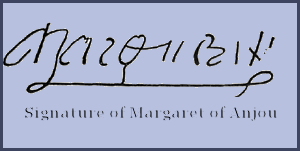 Queen Margaret lead a Lancastrian army to attack the Duke of York at his castle at Sandal. The Duke was killed leading an impulsive charge against the Lancastrian forces, as was Salisbury and York’s second son, the seventeen year old Edmund, Earl of Rutland, whose pleas for his life were ignored. The Queen had their heads impaled on spikes on the city walls of York.
Queen Margaret lead a Lancastrian army to attack the Duke of York at his castle at Sandal. The Duke was killed leading an impulsive charge against the Lancastrian forces, as was Salisbury and York’s second son, the seventeen year old Edmund, Earl of Rutland, whose pleas for his life were ignored. The Queen had their heads impaled on spikes on the city walls of York.
Edward, Earl of March, York’s able eldest son, aged eighteen and now leader of the Yorkist cause, retaliated and defeated the Lancastrians at Mortimers Cross. He continued to utterly crush the Lancastrian cause at the decisive and bloody Battle of Towton in Yorkshire. Margaret and her son took flight to Scotland where they found refuge and the new Duke of York was crowned at Westminster as King Edward IV. King Henry VI was eventually taken prisoner in Lancashire and imprisoned in the Tower of London.
The Restoration of Henry VI
Edward IV shocked the nobility when he announced he had been secretly married to Elizabeth Woodville, the beautiful but penniless widow of a Lancastrian knight. The new King had hoped to make the highly attractive Elizabeth his mistress, but she held out for marriage and Edward eventually succumbed to her charms. The old established nobility, and in particular Warwick, where alienated by the meteoric advancement of the new Queen’s large and needy family. In 1470, Warwick, later referred to as the Kingmaker, seething with hatred of the “upstart” Woodvilles, changed his allegiance to the House of Lancaster and was re-united with Margaret of Anjou under the auspices of Louis XI.
Edward IV was forced to flee the country before Warwick and King Henry VI was briefly restored. A sad and pitiful figure, he was paraded through the streets of London in a shabby blue gown by George Neville, Archbishop of York and set up as a puppet King, whom the ambitious Warwick ruled through. Edward IV returned to England and defeated and killed his cousin Warwick at the Battle of Barnet. On Edward’s return to London, Henry greeted him, stating, “Cousin of York, you are very welcome. I hold my life to be in no danger in your hands.” The Yorkist King returned Henry to his former lodgings in the Tower and rode out to meet Margaret and her son who had landed in England on the day that Barnet was fought.
Their two armies clashed at Tewkesbury on 4th May 1471. Edward, the Lancastrian Prince of Wales, was killed either in battle or during its aftermath, there are several versions concerning how Edward, the , met his end, one states he was cut down as he fled north in the aftermath of the Battle of Tewkesbury, another states that following the rout of the Lancastrians at Tewkesbury, a small contingent of men under the Duke of Clarence found Edward near a grove, where he was immediately beheaded on a makeshift block, despite pleas for mercy to his brother-in-law Clarence. An alternative version was given by three other sources: The Great Chronicle of London, Polydore Vergil and Edward Hall, which was the version used by Shakespeare. This records, that Edward, having survived the battle and was taken captive and brought before Edward IV who was with George, Duke of Clarence; Richard, Duke of Gloucester; and William, Lord Hastings. The king received the prince graciously, and asked why he had taken up arms against him. The prince replied defiantly, “I came to recover my father’s heritage.” The king then struck the prince across his face with his gauntlet hand and those present with the king then suddenly stabbed Prince Edward with their swords.
The fate of Margaret of Anjou
Queen Margaret was defeated at last by the death of the son she had fought so long and hard for. She was imprisoned in the Tower of London. Her beloved son’s widow, Anne Neville, later married one of his suspected killers, Richard, Duke of Gloucester, through this marriage, Gloucester eventually obtained much of Warwick’s vast estates.
Margaret’s ageing but ebullient father, Rene of Anjou, remained unconcerned about his daughter’s fate, having recently remarried, he was preoccupied with his new young wife. Margaret was later removed to Windsor Castle, then on to Wallingford. She remained a prisoner until she was ransomed by her kinsman, Louis XI, at the Treaty of Picquigny in 1475. The embittered ex-Queen retired to her native Anjou, where she took up residence at the Chateau of Dampierre, she died there in August, 1482, aged fifty-three.
The Murder of Henry VI
Henry VI met his death in the Tower of London, on the night of the Vigil of the Ascension, 21st -22nd May, 1471. The demise of his son at Tewkesbury had sealed his fate. While Edward of Lancaster still lived, he rendered the removal of Henry pointless.
The Yorkist version of his end, that he died of “pure melancholy and displeasure” on hearing on of his son’s death was not much accepted, even at the time. His death so soon after that of his son seems unlikely to have been a coincidence. The Yorkist version of his end, that he died of “pure melancholy and displeasure” on hearing on of his son’s death was not much accepted, even at the time. His death so soon after that of his son seems unlikely to have been a coincidence.
The majority of contemporary chroniclers believed Henry had been murdered. After the passage of over five hundred years this can never be properly ascertained, Richard Duke of Gloucester was known to be present at the Tower that night, as where others.
W.J. White in his discussion in ‘The Death and Burial of Henry VI, A Review of the Facts and Theories, Part I’, White reveals that the earliest sources recording Henry’s death do not name athe murderer, although they assume that there was a murder and that Edward IV must have given the order for it. The first to name Richard of Gloucester as the murderer is probably the Frenchman Philippe de Commines writing in around 1490 and John Rous in his Historia de Regibus Anglie, written around the same time. Ultimately, the responsibility for Henry’s murder can only be laid at the feet of Edward IV. Edward had now exterminated the direct line of the House of Lancaster with ruthless efficiency.
Henry was buried at Chertsey. The cult of ‘Holy King Henry’, although actively discouraged by Edward IV, grew up after his death, when miracles were supposed to have occurred on pilgrimage to his tomb.
Henry’s body was moved to Windsor by Richard III, an act perhaps occasioned by an uneasy conscience and his overriding desire for the souls of his victims to rest in peace. An unsuccessful attempt was made by Henry VII, the first Tudor monarch, to have his half-uncle canonized.
Due to controversy over the manner of his death, George V gave permission to exhume the body of King Henry VI in 1910. The skeleton was found to have been dismembered before being placed in the box and not all the bones were present. Three very worn teeth were found and the only piece of jaw present had lost its teeth before death. The bones were recorded as being those of a strong man measuring five feet nine to five feet ten inches tall. Light brown hair found matted with blood on the skull confirmed that Henry VI had died as a result of violence.
A marble tablet placed in the Wakefield Tower in his memory marks the spot where Henry VI is traditionally said to have met his untimely end. Each year, on the eve of the anniversary of his death, the ceremony of the lilies and the roses is played out, white lilies for Eton College and white roses for King’s College, Cambridge are placed there in memory of their founder.
Credits:
Wikipedia
http://www.englishmonarchs.co.uk/
http://www.britroyals.com/

